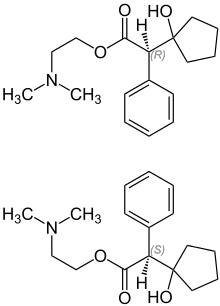Cyclopentolate
Cyclopentolate is a medication commonly used during pediatric eye examinations that dilates the eye (mydriatic), prevents accommodation of the eye to different distances (cycloplegic), and blocks specific receptors called muscarinic receptors (muscarinic antagonist).[1] Cyclopentolate is also administered as an atropine substitute to reverse muscarinic and central nervous system effects of indirect cholinomimetic (anti-AChase) administration.
When used in eye drops in paediatric eye examinations, cyclopentolate 0.5 percent and 1.0 percent is used to stop the eye focusing at any distance closer than infinity. This enables the ophthalmologist or optometrist to obtain a more accurate reading of the correcting lenses required for clear vision at distance. Brand names include Cyclogyl, Cylate, & Pentolair.[2]
The drops take around 30–60 minutes to work and usually less than 24 hours (pupil dilation could last up to 96 hours) to wear off (with patients advised not to drive a vehicle or operate machinery for at least 12 hours). The pupils become wider when cyclopentolate is administered, making the eyes more sensitive to light. Close objects (and possibly distant objects) will also appear blurred.
Side effects to cyclopentolate are rare, but can include effects such as disorientation, incoherent speech or visual disturbances during the 24-hour period that the drug has an effect. The side effects are more common in children.

Pupil dilation (
mydriasis) caused by cyclopentolate 1% instilled into both eyes
References
{{cite book|author1=John P.Whitcher |author2=Paul Riordan-Eva |title=Vaughan & Asbury's general ophthalmology.|publisher=McGraw-Hill Medical|isbn=978-0071443142|page=63|edition=17th}}</ref>; -webkit-column-width: refs
[3]; column-width: refs
[3]; list-style-type: decimal;">
- ↑ "Cyclopentolate". Retrieved June 15, 2012.
- ↑ "cyclopentolate hydrochloride solution - ophthalmic, Cyclogyl, Cylate, Pentolair". Retrieved June 15, 2012.
- 1 2 John P.Whitcher; Paul Riordan-Eva. Vaughan & Asbury's general ophthalmology. (17th ed.). McGraw-Hill Medical. p. 63. ISBN 978-0071443142.
|
|---|
|
| |
|---|
| | mACh |
- Muscarinic antagonists: 3-Quinuclidinyl benzilate
- 4-DAMP
- Aclidinium bromide
- Anisodamine
- Anisodine
- Antihistamines (first-generation) (e.g., brompheniramine, chlorphenamine, cyproheptadine, dimenhydrinate, diphenhydramine, doxylamine, mepyramine (pyrilamine), phenindamine, pheniramine, promethazine, tripelennamine, triprolidine)
- Atropine
- Atropine methonitrate
- Atypical antipsychotics (e.g., clozapine, olanzapine, quetiapine, zotepine)
- Benactyzine
- Benzatropine (benztropine)
- Benzilylcholine mustard
- Benzydamine
- BIBN 99
- Biperiden
- Bornaprine
- CAR-226,086
- CAR-301,060
- CAR-302,196
- CAR-302,282
- CAR-302,368
- CAR-302,537
- CAR-302,668
- Caramiphen
- Cloperastine
- CS-27349
- Cyclobenzaprine
- Cyclopentolate
- Darifenacin
- DAU-5884
- Dimethindene
- Dexetimide
- DIBD
- Dicyclomine (dicycloverine)
- Ditran
- EA-3167
- EA-3443
- EA-3580
- EA-3834
- Etanautine
- Etybenzatropine (ethybenztropine)
- Flavoxate
- Himbacine
- HL-031,120
- Ipratropium bromide
- J-104,129
- Hyoscyamine
- Mamba toxin 3
- Mamba toxin 7
- Mazaticol
- Mebeverine
- Methoctramine
- Metixene
- N-Ethyl-3-piperidyl benzilate
- N-Methyl-3-piperidyl benzilate
- Orphenadrine
- Otenzepad
- Oxybutynin
- PBID
- PD-102,807
- PD-0298029
- Phenglutarimide
- Phenyltoloxamine
- Pipenzolate bromide
- Pirenzepine
- Piroheptine
- Procyclidine
- Profenamine
- Revefenacin
- RU-47,213
- SCH-57,790
- SCH-72,788
- SCH-217,443
- Scopolamine (hyoscine)
- Sofpironium bromide
- Solifenacin
- Telenzepine
- Tetracyclic antidepressants (e.g., amoxapine, maprotiline, mianserin, mirtazapine)
- Timepidium bromide
- Tiotropium bromide
- Tolterodine
- Tricyclic antidepressants (e.g., amitriptyline, butriptyline, clomipramine, desipramine, dosulepin (dothiepin), doxepin, imipramine, lofepramine, nortriptyline, protriptyline, trimipramine)
- Trihexyphenidyl
- Tripitamine
- Tropacine
- Tropatepine
- Tropicamide
- Typical antipsychotics (e.g., chlorpromazine, loxapine, thioridazine)
- WIN-2299
- Xanomeline
- Zamifenacin
|
|---|
| | nACh |
- Nicotinic agonists: 5-HIAA
- A-84,543
- A-366,833
- A-582,941
- A-867,744
- ABT-202
- ABT-418
- ABT-560
- ABT-894
- Acetylcholine
- Altinicline
- Anabasine
- Anatoxin-a
- AR-R17779
- Butinoline
- Butyrylcholine
- Carbachol
- Choline
- Cotinine
- Cytisine
- Decamethonium
- Desformylflustrabromine
- Dianicline
- Dimethylphenylpiperazinium
- Epibatidine
- Epiboxidine
- Ethanol
- Ethoxysebacylcholine
- EVP-4473
- EVP-6124
- Galantamine
- GTS-21
- Ispronicline
- Ivermectin
- Levamisole
- Lobeline
- MEM-63,908 (RG-3487)
- Morantel
- Nicotine (tobacco)
- NS-1738
- PHA-543,613
- PHA-709,829
- PNU-120,596
- PNU-282,987
- Pozanicline
- Rivanicline
- RJR-2429
- Sazetidine A
- SB-206553
- Sebacylcholine
- SIB-1508Y
- SIB-1553A
- SSR-180,711
- Suberyldicholine
- Suxamethonium (succinylcholine)
- TC-1698
- TC-1734
- TC-1827
- TC-2216
- TC-5214
- TC-5619
- TC-6683
- Tebanicline
- Tropisetron
- UB-165
- Varenicline
- WAY-317,538
- XY-4083
|
|---|
|
|
|
|
|
| |
|---|
| | ChAT |
- Inhibitors: 1-(-Benzoylethyl)pyridinium
- 2-(α-Naphthoyl)ethyltrimethylammonium
- 3-Chloro-4-stillbazole
- 4-(1-Naphthylvinyl)pyridine
- Acetylseco hemicholinium-3
- Acryloylcholine
- AF64A
- B115
- BETA
- CM-54,903
- N,N-Dimethylaminoethylacrylate
- N,N-Dimethylaminoethylchloroacetate
|
|---|
| | AChE | |
|---|
| | BChE |
- Inhibitors: Cymserine
- Many of the AChE inhibitors listed above
|
|---|
|
|
|
|
|
|
